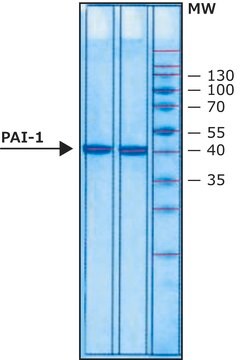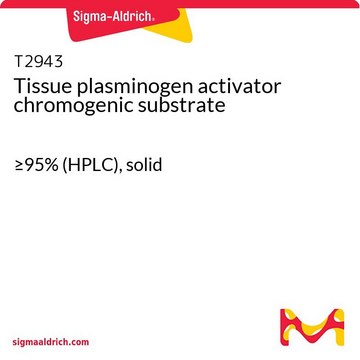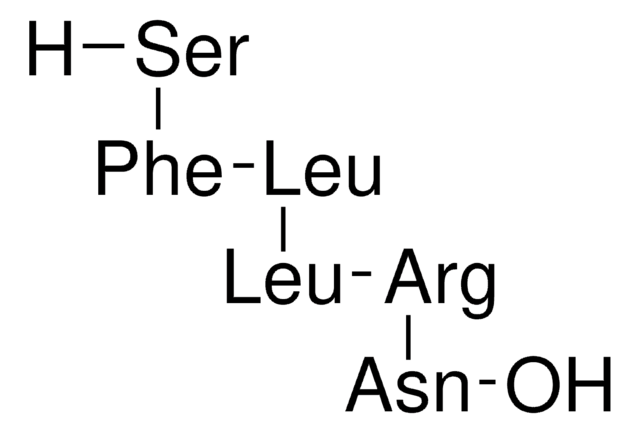528205
Plasminogen Activator Inhibitor-1, Human, Recombinant
The Plasminogen Activator Inhibitor-1, Human, Recombinant controls the biological activity of Plasminogen Activator. This small molecule/inhibitor is primarily used for Protease Inhibitors applications.
Synonim(y):
PAI-1
Zaloguj sięWyświetlanie cen organizacyjnych i kontraktowych
About This Item
Kod UNSPSC:
12352200
NACRES:
NA.77
Polecane produkty
Poziom jakości
Próba
≥98% (SDS-PAGE)
Postać
liquid
producent / nazwa handlowa
Calbiochem®
warunki przechowywania
OK to freeze
avoid repeated freeze/thaw cycles
Warunki transportu
wet ice
temp. przechowywania
−70°C
Opis ogólny
PAI-1 is the primary inhibitor of both tissue plasminogen activator (tPA) and urokinase (uPA). PAI-1 can exist either in an active inhibitory conformation or in an inactive or latent conformation. This highly purified preparation has not been exposed to denaturing conditions and has been chromatographically purified of latent material. PAI-1 is a marker for acute myocardial infarction and several thrombolytic disorders. Protects platelets against the inhibitory effects of plasma. Reported to be an important prognostic factor in breast cancer patients. PAI-1 is highly stable when stored at or below pH 6.6.
Primary inhibitor of both tissue plasminogen activator (tPA) and urokinase (uPA). PAI-1 is synthesized by vascular epithelium and hepatocytes. Used as a marker for acute myocardial infarction and in the diagnosis of several thrombolytic disorders. Protects platelets against the inhibitory effects of plasma. Shown to have a role complimentary to that of α2-anti-plasmin. Elevated levels are found in subjects with accelerated coronary artery disease. PP1 activity may limit the extent of metastasis, since uPA activity is a major contributory factor promoting dissolution of tumor matrix and basement membrane. May serve as an independent and strong prognosticator in breast cancer patients. Patients having elevated levels of PAI-1 in their primary tumors are more prone to relapse. Can exist either in an active inhibitory conformation or in an inactive or latent conformation. This highly purified preparation has not been exposed to denaturing conditions and has been chromatographically purified free of the inactive material.
Działania biochem./fizjol.
Cell permeable: no
Primary Target
Tissue plasminogen activator (tPA) and urokinase (uPA)
Tissue plasminogen activator (tPA) and urokinase (uPA)
Product does not compete with ATP.
Reversible: no
Ostrzeżenie
Toxicity: Standard Handling (A)
Postać fizyczna
In 150 mM NaCl, 50 mM sodium phosphate buffer, 1 mM EDTA, pH 6.6.
Rekonstytucja
Following initial thaw, aliquot and freeze (-70°C).
Inne uwagi
Vaughan, D.E., et al. 1995. J. Clin. Invest. 95, 995.
Dimitri, G., et al. 1993. Boll. Chim. Farmaceutico 132, 272.
Janicke, F., et al. 1993. Breast Cancer Res. Treatment 24, 195.
Klasser, K.J., et al. 1993. Coron. Artery Dis. 4, 713.
Robbie, L.A., et al. 1993. Thromb. Hemost.70, 307.
Lawrence, D., et al. 1989. Eur. J. Biochem.186, 523.
Collen, D. and Lijnen, H.R. 1987. In The Molecular Basis of Blood Diseases (Stamatoyannopoulus, G., et al. Eds.) W.B. Saunders
Ginsberg, D., et al. 1986. J. Clin. Invest.78, 1673.
Vassalli, J.D., et al. 1985. J. Cell Biol.100, 86.
Dimitri, G., et al. 1993. Boll. Chim. Farmaceutico 132, 272.
Janicke, F., et al. 1993. Breast Cancer Res. Treatment 24, 195.
Klasser, K.J., et al. 1993. Coron. Artery Dis. 4, 713.
Robbie, L.A., et al. 1993. Thromb. Hemost.70, 307.
Lawrence, D., et al. 1989. Eur. J. Biochem.186, 523.
Collen, D. and Lijnen, H.R. 1987. In The Molecular Basis of Blood Diseases (Stamatoyannopoulus, G., et al. Eds.) W.B. Saunders
Ginsberg, D., et al. 1986. J. Clin. Invest.78, 1673.
Vassalli, J.D., et al. 1985. J. Cell Biol.100, 86.
Informacje prawne
CALBIOCHEM is a registered trademark of Merck KGaA, Darmstadt, Germany
This page may contain text that has been machine translated.
Kod klasy składowania
10 - Combustible liquids
Klasa zagrożenia wodnego (WGK)
WGK 1
Temperatura zapłonu (°F)
Not applicable
Temperatura zapłonu (°C)
Not applicable
Certyfikaty analizy (CoA)
Poszukaj Certyfikaty analizy (CoA), wpisując numer partii/serii produktów. Numery serii i partii można znaleźć na etykiecie produktu po słowach „seria” lub „partia”.
Masz już ten produkt?
Dokumenty związane z niedawno zakupionymi produktami zostały zamieszczone w Bibliotece dokumentów.
Nasz zespół naukowców ma doświadczenie we wszystkich obszarach badań, w tym w naukach przyrodniczych, materiałoznawstwie, syntezie chemicznej, chromatografii, analityce i wielu innych dziedzinach.
Skontaktuj się z zespołem ds. pomocy technicznej





